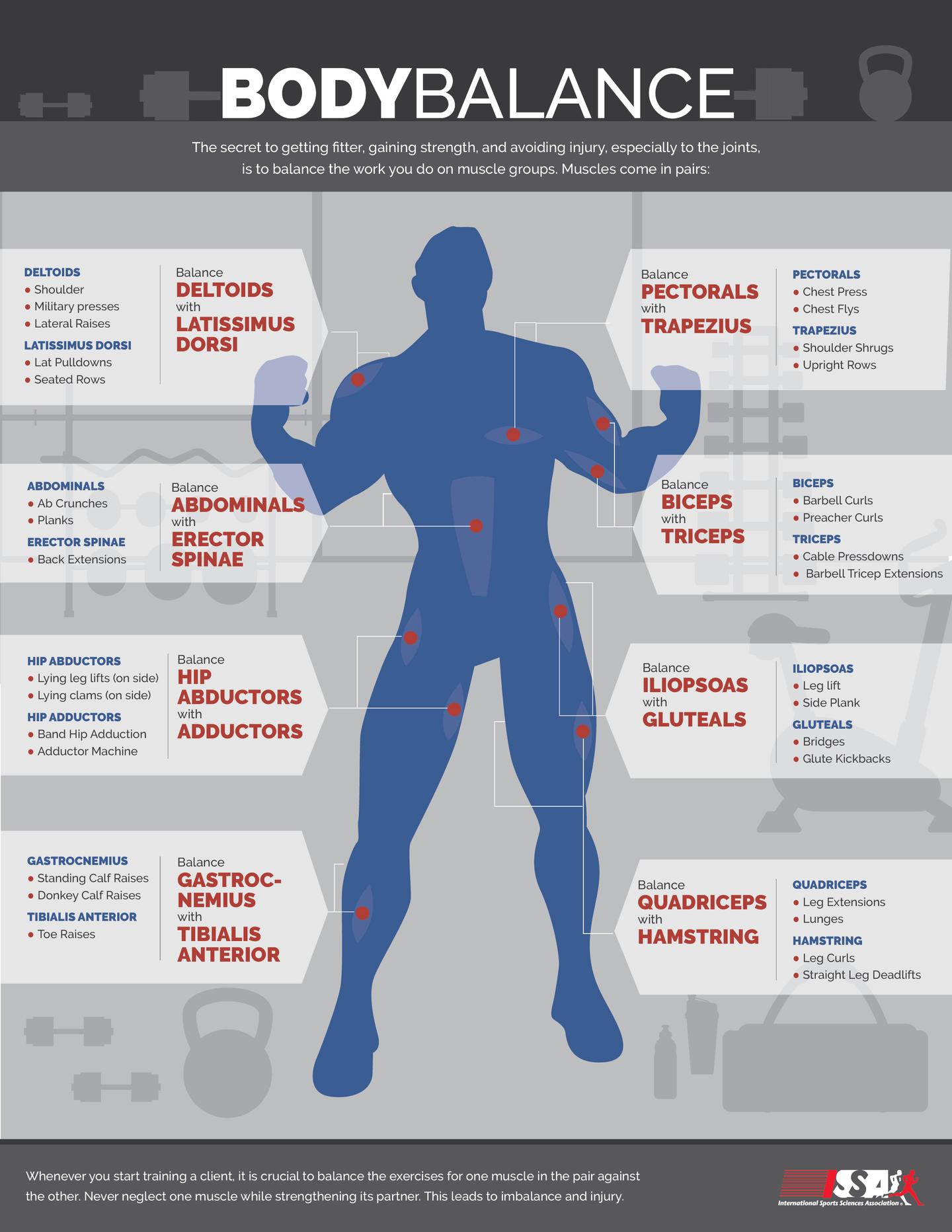
What is Body Balance and Why Should You Care?
Reading Time: 4 minutes 38 seconds
BY: Jennifer Sargent Byrd
DATE: 2016-05-31
As a trainer you know that you can't just go into the gym without a plan and start throwing the weights around, right?
But do your clients know that? Do they really get how much goes into planning a strength training session?
Do your clients realize that there is a reason for the order, repetitions, and weights for the exercises you run them through?
More importantly, do you understand how to train your clients to get stronger while avoiding injury?
The secret to getting fitter, gaining strength, and avoiding injury, especially to the joints, is to balance the work you do on muscle groups. Muscles come in pairs.
The major muscle groups work in pairs and those muscle pairs need to be balanced in terms of strength and flexibility.
Whenever you start training a client, it is crucial to balance the exercises for one muscle in the pair against the other. Never neglect one muscle while strengthening its partner. This leads to imbalance and injury.
Below you can click on the image and see how one muscle balance another: Biceps and Triceps, Deltoids and Lattisimus dorsi, Pectorals and Trapeziusk Abdominals and Erector spinae, Quadriceps and Hamstrings, Hip abductors and Adductors, Gastrocnemius and Tibialis anterior, Iliopsoas and Gluteals.
This infographic can easily be printed out on a 8.5 x 11 paper to share with your clients (Click here to go to pinterest to print out).

Why is Muscle Balancing So Important?
Most people walk into a gym and ‘experiment' on the machines having no idea how important it is to achieve balance.
The next time clients asks why you are putting them through such a precise and well-planned routine, tell them this:
Balance between muscle pairs prevents injury.
When muscles are unbalanced, you use your joints incorrectly and cause wear, tear, and damage over time. Unbalanced muscles can also cause pain.
As an example, think of a weight lifter who is really focused on his pectorals. He spends less time on the traps. When he stands or walks, he stoops forward because his pecs are stronger than his traps.
The result? Poor posture and eventually neck and back pain.
How about another example?
Knee damage and pain is pretty common. You can help your clients avoid it by balancing the training of their hip abductors and adductors. When these are balanced and strong they pull the tendons holding the kneecap into place.
When one of these muscles is weaker, the kneecap gets pulled out of place, and the result is pain and possibly even an injury if you move the wrong way.
How to Get Good Muscle Balance
So how does this work? If you Google "Body Balance" you will see a lot of advertising for vitamins and pilates.
But...with all my experience in bodybuilding I know that the best balance comes from weight training period!
Cross-training is always a good thing but the very best way is to achieve total fitness and muscle balance is a combination of cardiovascular exercise and weight training. Weight training offers specific possibilities to achieve balance over and above any other form of exercise.
Of course, you can't just weight train any old way. You have to train each side of your body—or your client's—equally.
Everyone has a weaker side, and a weaker muscle within each of the pairs listed above. The key to achieving body balance and avoiding injury is to strengthen up the weaker muscle and then to train each equally once you achieve that balance.
Find Your Client's Weakness
Getting muscles in balance isn't really tricky. You just have to know which muscles are weaker and focus your efforts there.
Most people have natural imbalances due to the way we move throughout the day.
For example, most people have weaker triceps then biceps because of how we lift things. We tend to have weaker gluteals than iliopsoas because we walk forwards more than backwards. Most people are weaker on the left side of the body because most of us are right-handed.
Once you understand these natural imbalances, you can simply focus more effort on the weaker muscles until they are balanced out with the others.
Try Negative Training
Here's a strategy you can use to bulk up your client's weaker muscles. It not only improves muscle balance, but it is great for adding muscle mass fast.
Negative training means spotting your client on the lifting, or positive, half of an exercise and then letting your client do the negative half, or the lowering, without assistance.
Here's an example:
Have your client hold his/her arms up in the extended position for overhead triceps extensions. Put the weights in your client's hands and let her/him slowly lower them, really focusing on the strength in her triceps. Repeat.
Maintain the Balance
Once you have focused on balancing out your client's weaker muscles with her stronger ones, train in a way that maintains that good muscle balance.
Let's say my client Joan and I are working on her legs and back one day. I start with giving her knee extensions with a light 55 pounds for a warm up. To keep her balanced, I have her do ten reps each with her toes pointed straight, pointed in, and pointed out.
This particular set of exercises is great for balance in the muscles and tendons around the knees.
When we move to the inner and outer thigh machine to work the abductors and adductors, I employ negative training. I help her push the weight out, but then let her use the weight to slowly bring it back in.
This helps Joan balance all sides of her legs with close to matching weights which in turn protects the hips and knees.
Next it's on to the back. I use at least three different exercises targeting each major muscle. This means we not only hit every muscle, but every area of every muscle for maximum balance.
Like when we do triceps, we do exercises overhand, underhand, and with rope pull downs.
Repetitions and Weights
There will always be debate in the fitness industry over repetitions versus weights. Some people like to use heavier weights with fewer reps, while others sing the praises of lighter weights and more reps.
You'll find me in the latter camp. Bodybuilders and powerlifters who focus primarily on heavy resistance and low repetitions can be more vulnerable to tendinitis. By using slightly lighter weights with a repetition range generally around 8 to 15 repetitions, you can achieve muscle gains while also strengthening tendons and avoiding injury.
To really push muscle conditioning in a particular area, I have my clients get into high-rep burnouts: lighter weights with higher repetitions.
Balance in muscle strength is so important. By strengthening every part of every muscle, you help your clients get sleek, strong, balanced bodies and avoid injury and pain.